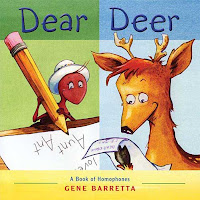Genre: Fiction
Theme: Animals/Food
Ages: 3-6 years
Summary: If you give a cat a cupcake, he'll ask for sprinkles to go with it. Which spirals into a whole story of "If....then..." scenarios which are so silly and fun the reader will be delighted. The story finally loops back to the sprinkles and cupcake to bring the ending full circle.
Link to Picture
Pre-Reading Activity: Introduce the story a mini lesson on cause and effect. The "if...then..." scenarios of the story are a great way to solidify the concept. Ask students if they have ever been told by their parent that "If you finish your vegetables, then you can have dessert". Explain the cause and effect works with weather, if it rains then you have to use an umbrella. As class if they can think of examples of cause and effect. Tell students that this story will have many causes and effects and to be listening closely for them.
Post-Reading Activity: Have students write about an "if...then..." scenario in their life. This can be a free write activity in a journal, or a worksheet created by instructor. Students may model cat and cupcake examples from the text, or create ones of their own.
Reflection: When I was a child I loved reading through the mouse and moose books in this series. This story is full of animals, foods, sequences, and a fun series of events that will keep children excited and laughing along.

















